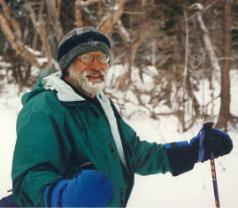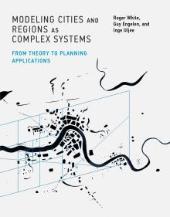Roger White
 Department of Geography
Department of Geography
Memorial University of Newfoundland
St. John's, NL
A1B 3X9
Office: SN 2023
Tel: (709) 864-8999
Fax: (709) 864-3119
E mail: roger[at]mun[dot]ca
I received my PhD in theoretical and economic geography at the University of North Carolina, Chapel Hill, following a BA (honours) in economics and philosophy at Swarthmore College. Prior to coming to Memorial in 1977, I taught at the University of Western Ontario. I have also held visiting positions at McGill University (Montréal), the University of California at Santa Barbara, the Université de Dijon (now Université de Bourgogne), France, the Université Libre de Bruxelles, Belgium; a consultancy at Los Alamos National Laboratory; and a residency at the Santa Fe Institute. In 2008-2009 I was the Science Foundation Ireland E.T.S. Walton Visiting Professor in Information and Communication Technologies at the Urban Institute Ireland, University College Dublin.
For a number of years beginning in 1990, I was associated with the Research Institute for Knowledge Systems (RIKS) in Maastricht, The Netherlands, where I collaborated in the development of new techniques for modelling the dynamics of geographical systems, and since 2007 I have been involved with the Flemish Institute for Technological Research (VITO) in Mol, Belgium, where I continue to develop new models and modelling techniques aimed at a deeper understanding of change in urban and regional systems.
Research Interests
- The theory of urban and regional systems.
- Integrated modelling of geographical systems.
- Individual based modelling of economic systems.
- Formal representations of structural evolution in economic and geographic systems.
- Philosophical and methodological issues in the validation of models of complex adaptive systems with open futures.
- Emergence and innovation.
In general, my geographical research is aimed at understanding cities and regions as complex, self-organizing, dynamic systems. Currently I am using cellular automata as a tool for modelling land use change as well as change in the spatial distribution of population and economic activities, and then using these models as a platform for integrating models of other related phenomena—for example, economic, demographic, and environmental models. These integrated models provide insight into the complex ways that natural and human systems behave as they interact with each other. Currently they are being tested as decision support and planning tools by the Dublin Regional Authority (Ireland), the Flemish Region (Belgium), the Plan Board of Puerto Rico, and others.
Since geographical systems, like the social and economic systems that underlie them, are characterised by the emergence of new entities, and new relationships linking them to existing elements of the system, much of my current research is focussed on ways of modelling emergence. To date almost all formal research in this area has dealt with the appearance of new patterns or structures within a given dynamical system. An example would be the spontaneous appearance of large scale circulation patterns like hurricanes. A more challenging problem is the emergence of new types of entities, together with their relations with existing elements of the system—an emergence which transforms the system into another, different system. This is a problem of central importance, since this type of emergence is the fundamental driver of change in human systems. How does a system evolve? That is, how does it cease to be the system that it was and become a new system, a system composed of different—novel—elements, within a new structure, one characterized by different properties and functions?
It is important to develop a formal understanding of such systems because they are the ones that we live in, and evolutionary changes to these systems are the most significant ones that they undergo. For example, changes to the structure of an economy, in terms of institutions, technology, and products are in the long run more significant than the sort of phenomena dealt with by current theory, such as changes in price or output level. Clearly, there are practical benefits to being able to understand and foresee the major outlines of the possible ways our future may unfold, and the consequences of our actions today for our possible futures. The aim is to develop a formal framework for understanding emergence and structural evolution. In this work I am collaborating with colleagues in computer science and philosophy.
Publications
A complete list of publications can be found on my Google Scholar author page: R White
If you are unable to download a paper that interests you, please e-mail me.
Book
Roger White, Guy Engelen and Inge Uljee. 2015. Modeling Cities and Regions as Complex Systems: From Theory to Planning Applications. MIT Press. 344 pp., 93 b&w illus., 17 tables, 15 color plates. ISBN: 9780262331364.
 This book describes the theory and practice of modeling the spatial dynamics of urban growth and transformation. The approach is based on the theory of self-organizing systems. The book presents a series of cellular automata (CA) based computational models. It also provides discussions of the theoretical, methodological, and philosophical issues that arise from the models. Case studies illustrate the use of the models in urban and regional planning. Finally, the book presents a new, dynamic theory of urban spatial structure that emerges from the models and their applications.
This book describes the theory and practice of modeling the spatial dynamics of urban growth and transformation. The approach is based on the theory of self-organizing systems. The book presents a series of cellular automata (CA) based computational models. It also provides discussions of the theoretical, methodological, and philosophical issues that arise from the models. Case studies illustrate the use of the models in urban and regional planning. Finally, the book presents a new, dynamic theory of urban spatial structure that emerges from the models and their applications.
Recent Publications
- Recio, G., Banzhaf, W. and White, R. From Dynamics to Novelty: An Agent-based Model of the Economic System. Artificial Life, 28 (2022).
- White, R. and Banzhaf, W. “Putting Natural Time into Science”. In A. Adamatzky and V. Kendon (eds) From Astrophysics to Unconventional Computing: Essays presented to Susan Stepney on the occasion of her 60th birthday. Springer (2020), pp. 1-21.
- Recio, G., Banzhaf, W. and White, R. “A study of Severe Disruption in an Artificial Economy.” Proceedings of the ALIFE 2020: The 2020 Conference on Artificial Life. MIT Press (2020), pp. 180-187. https://doi.org/10.1162/isal_a_00336.
- White, R. “Urban Morphogenesis: Putting Mathematics in Its Place”. In L. D’Acci (ed) The Mathematics of Urban Morphology. Birkhauser (2019), pp. 483-490.
- White, R., Crols, T. and Engelen, G. “Modelling the Spatial Dynamics of Population, Economic Activity and Land Use for Policy and Planning”. In Applied Urban Modelling: Assessing pathways towards productive, livable and sustainable city regions. Ying, J., ed. London: British Academy.
- White, R. “Forward” to Geomatic Approaches for Modelling Land Change Scenarios. Camacho Olmedo, M; Paegelow, M; Mas, J; Escobar, F. (eds.). Springer (2017).
- Crols, T., Vanderhaegen, S., Canters, F., Engelen, G., Poelmans, L., Uljee, I. and White, R. “Downdating high-resolution population density maps using sealed surface cover time series”. Landscape and Urban Planning, vol. 160 (2017), pp. 96–106.
- Banzhaf, W., Baumgaertner, B., Beslon, G., Doursat, R., Foster, J., McMullin, B., Veloso de Melo, V., Miconi, T., Spector, L., Stepney, S. and White, R. “Defining and Simulating Open-Ended Novelty: Requirements, Guidelines, and Challenges”. Theory in Biosciences vol. 135 (2016), pp. 131–161. DOI: 10.1007/s12064-016-0229-7.
- Crols, T., White, R., Uljee, I., Engelen, G., Poelmans, L. and Canters, F. “A Travel time – Based Variable Grid Approach for an Activity-Based Cellular Automata Model”. International Journal of GIS, vol. 29 (2015), pp. 1752-81.
- Pérez, L., Dragicevic, S.and White, R. Computers, Environment and Urban Systems (2013), vol. 39, pp. 121-135.
- Straatman, B., Marceau, D., and White, R. “A generic Framework for a Combined Agent-based Market and Production Model”. Computational Economics (2013), vol. 41, pp. 425-445.
- Jin, X. and White, R. “An Agent-Based Model Of The Influence Of Neighbourhood Design On Daily Trip Patterns”. Computers, Environment and Urban Systems (2012), vol. 36, pp. 398-412.
- White, R., Uljee, I. and Engelen, G. “Integrated Modelling Of Population, Employment, And Land Use Change With A Multiple Activity Based Variable Grid Cellular Automaton”. International Journal of GIS, vol. 26 (2012), pp. 1251-1280.
- Williams, B., Shahumyan, H., Boyle, I., Convery, S. and White, R. “Utilizing an Urban-Regional Model (MOLAND) for Testing the Planning and Provision of Wastewater Treatment Capacity in the Dublin Region 2006–2026”. Planning Practice and Research, vol. 27 (2012), pp. 227-248.
- van Vliet, J., van Delden, H., Hurkens, J., and White, R. “An Activity Based Cellular Automaton Model to Simulate Land Use Dynamics”. Environment and Planning B, vol. 39 (2012) pp. 198 – 212.
- Shahumyan, H., White, R., Petrov, L., Williams, B., Convery, S. and Brennan, M. "Urban Development Scenarios and Probability Mapping for Greater Dublin Region: The MOLAND Model Applications", Lecture Notes in Computer Science, vol. 6782, Part 1. Springer (2011), pp. 119-134.
- White, R., Shahumyan, H., and Uljee, I. “Activity Based Variable Grid Cellular Automata For Urban and Regional Modelling”. In Marceau, D. and Benenson, I., eds., Advanced Geosimulation Models. Bentham (2011), pp. 14-29.
- van Delden, H., Seppelt, R., White, R.,and Jakeman, A. “A Methodology for the Design and Development of Integrated Models for Policy Support”. Environmental Modelling & Software, vol. 26 (2011), pp. 266-279.
- Bone, C., Dragicevic, S.and White, R. “Modeling-in-the-Middle: Bridging the Gap between Agent-based Modeling and Multi-objective Decision Making for Land Use Change”. International Journal of GIS, vol. 25 (2010), pp. 717-737.
A few classics:
- Straatman, B., White, R., Banzhaf, W. “An Artificial Chemistry Based Model of Economics”. Artificial Life XI Artificial Life XI: Proceedings of the Eleventh International Conference on the Simulation and Synthesis of Living Systems. MIT Press (2008), pp. 592-599.
- Power, C., Simms, A. and White, R. “Hierarchical Fuzzy Pattern Matching for the Regional Comparison of Land Use Maps.” International Journal of GIS, vol. 15 (2001), pp. 77-100.
- White, R. and Engelen, G. “High Resolution Integrated Modelling of the Spatial Dynamics of urban and Regional Systems.” Computers, Environment, and Urban Systems, vol. 24 (2000), pp. 383-400.
- White, R., G. Engelen and I. Uljee. "The Use of Constrained Cellular Automata for High-resolution Modelling of Urban Land Use Dynamics," Environment and Planning B: Planning and Design, vol. 24 (1997), pp. 323-343.
- White, R. and G. Engelen. "Cellular Automata as the Basis of Integrated Dynamic Regional Modelling," Environment and Planning B: Planning and Design, vol. 24 (1997), pp. 235-246.
- White, R. and G. Engelen. "Cellular Automata and Fractal Urban Form: A Cellular Modelling Approach to the Evolution of Urban Land Use Patterns." Environment and Planning A, vol. 25 (1993), pp. 1175 - 1199.
- White, R. “Dynamic Central Place Theory: Results of a Simulation Approach”, Geographical Analysis, vol. 9 (1977), pp. 226-243.